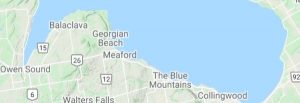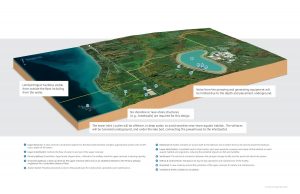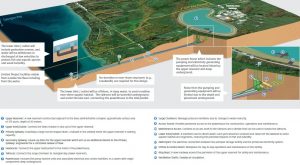Overview
As we move towards increasing the use of renewable energy such as wind and solar (and the associated fluctuating supply from those energy sources), and reducing our dependence on natural gas power to meet high demand periods, the Ontario government has recognized that we need sufficient energy storage to balance the grid. This is the rationale for TC Energy (TCE) to propose an open-loop pumped energy storage system at Meaford and for the government to consider their proposal.
The government agencies responsible for the TC Energy project, the Independent Electricity System Operator (IESO) and the Ontario Ministry of Energy (MoE), have already moved ahead with tendering for eight 250 MW battery storage projects. Pumped storage is viewed as long-term storage, while battery storage is seen as a medium-term option, due to the respective longevity of the equipment for the two project types.

Although the TCE project is proposed for a site on the west coast of Georgian Bay, GBA is examining it because we have several concerns about its potential environmental impacts, notably a potential increase to fish mortality, water turbidity, water temperatures, and habitat destruction. These impacts could affect all of Georgian Bay, and we are concerned about the precedent it will set.
GBA continues to gather information on the proposal from TCE, the Department of National Defence (DND) and a local group opposed to the project, Save Georgian Bay (SGB). As we move forward, we will continue our research and discuss our findings with all appropriate stakeholders.
Since we started working on this project in September 2019, GBA, SGB, and others have been instrumental in persuading TCE to change the design to minimize the potential environmental impacts. More recently, feedback from GBA, SGB, the Township of the Archipelago (ToA), and others has resulted in the IESO and MoE delaying the final decision on the project until July 31, 2024.
Our aim is to ensure that GBA members have full, complete, and accurate information on the project, its potential environmental impacts, and how it stacks up financially against alternative storage methods for Ontario taxpayers. There have been, and will continue to be, opportunities for GBA members and Georgian Bay communities to then make informed decisions on whether or not to submit comments to the Ontario government.
GBA and SGB are currently focused on asking the government to open up this 1,000 MW long-term storage requirement to a competitive public tender, as recommended by IESO. This process is usually required for all government contracts.
On this webpage you will find the following information:
- How Will TC Energy’s Pumped Storage Project Impact Georgian Bay?
- What are the Alternatives?
- Benefits
- Potential Negative Impacts
- GBA Submissions
- Save Georgian Bay Information
- Additional Information
- News Articles
How Will TC Energy’s Pumped Storage Project Impact Georgian Bay?
Proposed Project
TCE is proposing to construct a large pumped storage facility just north of Meaford on land owned by the Department of National Defence (DND). The project is still at the feasibility stage and continues to move through the approval process with Ontario’s IESO.
TCE has recently renamed and updated their website, here: PoweredbyMeaford.com. It has full information on the Project and why they believe it should be supported.
A local group, Save Georgian Bay (SGB), has assembled a point-by-point rebuttal of TCE’s main claims about the project, which can be found here: SGB critique of TCE pumped storage project May 2023

How it Works
As per the diagrams, water would be pumped out of Georgian Bay via tunnels into the reservoir above at low off-peak hydro rates, when most of Ontario’s energy needs are being supplied by low-carbon energy sources such as nuclear and wind energy. It would then be released down the steep slope through the same tunnels, back into Georgian Bay, to generate power at peak demand times, when there is a higher use of natural gas-fired power plants. The current site was selected in part because it provides 150 m of vertical elevation above the Bay and is within 100 km of a power grid that can handle the level of power the project is projected to produce.

Key Statistics
- Output: 1,000 MW
- Stored energy: 8,000 MW (1,000 MW per hour for 8 hours)
- Flow rate in both directions: equivalent to 42% of the average flow rate over the Canadian side of Niagara Falls (Horseshoe Falls)
- Efficiency: ~67%
This efficiency factor means:
- The project takes approximately 12 hours to fill the upper reservoir, and can generate electricity for 8 hours thereafter; and
- For every 100 MW used to pump the water into the reservoir, ~67 MW is generated when the water is released.
What Are the Alternatives?
The IESO and MoE have determined that Ontario needs pumped electricity storage for a variety of reasons, including assisting the development of green energy, such as wind-power and solar, and reducing dependence on natural gas power to meet high demand periods.
Eight 250 MW battery storage projects are underway in Ontario, one of which (Oneida – Canadian Battery Energy Storage) is under construction and due to be completed by 2025. The other seven were sent out for tender in 2023.
This alternative to pumped storage has the advantage of a much shorter construction period and is ~87% efficient, vs pumped storage at ~67% efficient.
One of the key questions relates to the shifting demand for electricity at current off-peak times. As electric vehicle usage grows, together with other off-peak energy demands, the need for energy storage is expected to steadily diminish. What will the demand profile and the need for energy storage look like when the project is completed in 2032/33 (TCE’s current timing estimate)?
Pumped storage is designed to last around 50 years, and, with a major refurbishment, can last as long as 100 years. On the other hand, the batteries in battery storage projects slowly deteriorate over time and would have to be replaced every 20 years. That may change as battery technology develops. Batteries are steadily getting cheaper, whereas, according to TCE, the project’s estimated cost has gone from $4.5 to $7 billion, and experienced SGB engineers believe that a cost of $8-10 billion is more likely. These estimates mean that the capital cost for building pumped storage would be roughly double the capital cost for an equivalent battery storage.
For the above reasons, the IESO continues to advise the MoE not to proceed with the project, as they view it as a bad financial deal for Ontarians, and would like to see the project put out to competitive tender.
From GBA’s perspective, we are concerned about the risks of significant environmental impacts associated with the project when compared to battery storage, which has almost no local environmental impact.
Project Benefits
According to TCE, the primary benefits of this project include the following:
CO2 Emissions Savings
TCE commissioned Navigant to conduct an economic analysis of the project, which included calculating potential CO2 emissions savings. Navigant based their calculations on a range of future Ontario energy sector demand and supply scenarios, and showed average CO2 emissions savings of around 490,000 tonnes per year, and potentially more. SGB has questioned the accuracy of this study, please see pages 8.1 to 8.5 of their environmental assessment, which can be found here.
Grid Efficiencies and Savings
By capturing excess power that would otherwise be wasted and releasing it when needed at peak times, the project would enhance the efficiency, flexibility, reliability, and security of the Ontario electricity supply system. It would also provide back-up power during grid disruptions and better integrate other power generation facilities in the province. Collectively this grid balancing would reduce costs of electricity for Ontario consumers by an estimated $250 million per year.
However:
- Using more efficient recent technology (e.g., battery storage) would achieve the same objective at a much lower cost to Ontario taxpayers.
- The MoE has approved one 250 MW battery storage project, see details here, and has 7 others under tender, all 250 MW.
- All these battery storage projects will be in place in 2025-2027 (estimate), whereas, according to TCE, the earliest the project will come online is 2032/3.
- By 2032/3 it is expected that the current demand profile for Ontario power will change significantly, as more electric vehicles etc. are charged up at night. This could reduce the need for storage and change the price differential between peak and off-peak power.
Potential Negative Impacts
Intake/outflow system
The potential environmental impacts of this project include issues that relate to the design of the water intake/outflow system to be deployed. Since GBA and others have been expressing our concerns about the potential entrainment of fish and other aquatic biota, turbidity, sediment disturbance, and impacts on fish habitat and currents, TCE has made significant changes to the project’s design. The new design will:
- move the water intake/outflow pipe away from the shoreline
- incorporate tunnels installed beneath the lakebed that will lead to deep water to avoid sensitive near-shore fish habitat
- raise the intake/outflow structures off the lakebed to avoid bottom-dwelling aquatic organisms and the potential to create turbidity
- incorporate fixed screens and limit the speed of water intake and release, which would further protect fish and other aquatic biota
- locate the powerhouse (pump/turbines) away from the shoreline in an underground cavern and connect it to the water intake/outflow through underground tunnels
The original design was conceptually similar to the Ludington pumped storage project in Michigan that demonstrated consistently high rates of fish entrainment and other impacts, even after a successful lawsuit forced the installation of a net system to mitigate the damage.
TCE’s updated design addresses many of the original concerns of GBA and demonstrates that we can be cautiously optimistic that community feedback and efforts by GBA and others, will lead to substantial mitigation of potentially severe environmental impacts should the project proceed. GBA is still concerned and will follow events closely to ensure that the expected improvements from the design changes unfold as advised.
Any significant disturbance of lakebed sediment is a concern, because the DND has used this site as a training facility and firing range for decades, and there may be various pollutant in the sediment that could be released into nearby waters, including per-and polyfluoroalkyl substances (PFAS) and heavy metals.
Species at Risk
There are 30 species at risk recorded on the DND facility whose habitat could be destroyed or compromised, both from construction activity and the displacement of 375 acres of Niagara Escarpment to create the reservoir. The recent design changes, with facilities moved underground, show promise in reducing surface disturbances and the potential impacts to species at risk.
Hydro Line
TCE has proposed two solutions to connect the project to the provincial grid at Barrie – an overhead transmission system, or a subsea solution that would cross Georgian Bay. The subsea solution, the preferred transmission option for the project, could disrupt lakebed sediment and potentially impact the local marine environment and water quality.
The other option that will be evaluated is an on-land transmission route. While most of the hydro lines needed to connect to the grid at Barrie would be constructed along existing power corridors (with minimal impact), new sections may be required. These could cause some ecosystem damage, along with habitat disruption or destruction.
All the above potential negative environmental impacts will be evaluated and studied as part of the federal and provincial environmental impact assessments.
GBA Submissions
- GBA letter to the Ministry of Energy Aug 24, 2023
- GBA Submission to Department of National Defence – July 30, 2020
- GBA Submission to Meaford Mayor and Council May 27, 2020
Save Georgian Bay Information
The SGB website is: https://savegeorgianbay.ca/
You will find more details about the project here, including:
- SGB’s environmental impact assessment: https://savegeorgianbay.ca/wp-content/uploads/2022/01/Save-Georgian-Bay-Strategic-Environmental-Assessment-TCE-Pump-Storage-Plant-07-31-20-min.pdf
- SGB press releases and other press coverage: https://savegeorgianbay.ca/news/
Additional Information
Four Georgian Bay Municipalities Have Passed Resolutions Opposing the Project
Township of the Archipelago (ToA), Town of the Blue Mountains, Township of Georgian Bay (TGB), and the town 0f Parry Sound have all passed resolutions opposing the TC Energy Pumped Storage Project Georgian Bay. Only one of these municipalities is near Meaford, the other three are along the east coast of the Bay. This demonstrates that there is concern about the potential impact of this project throughout Georgian Bay and that opposition to the project is not just a local matter.
Read the resolutions:
- ToA TC Energy Pumped Storage Project Resolution – November 2023
- Town of Blue Mountains Resolution on TCE Pumped Storage Project – December 2023
- TGB TC Energy Pumped Storage Resolution – February 2024
- Town of Parry Sound Opposes TC Energy Pumped Storage Project – February 2024
TCE Website
Information posted by TCE on this project can be found on their website here.
Department of National Defence
The Department of National Defence (DND) completed it’s consultation process and have carried out an environmental assessment of the project’s impact on their land. See a summary of their findings here.
Minister of Energy
Minister of Energy issused a letter to the IESO, January 9, 2024, setting out requirements for TCE.
News Articles
- Controversy surrounds proposal for multi-billion-dollar energy storage facility in Meaford – CTV News – February 26, 2o24
- Ontario needs energy storage. Why is it holding out on two big projects? – The Narwhal – January 19, 2024
- You Asked us to go to Meaford. So we did – The Narwhal – November 23, 2023
- Despite the risk of military explosives, TC Energy wants to build ‘Ontario’s battery’ on Georgian Bay – The Narwhal – November 23, 2023
- The Mega Project on Georgian Bay – On the Bay Magazine – July 4, 2023
- Georgian Bay Pumped Storage Project is Far From a Done Deal – ParrySound.com – March 25, 2022
- The Business Behind Green Technology – On the Bay Magazine – December 14, 2020
- Choppy Water Ahead as Residents Battle Energy Giant Over Proposed Pump Storage Facility – CollingwoodToday.ca – July 18, 2020
